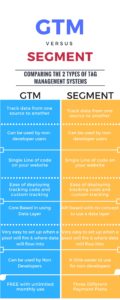When researching a tag management tool, it is important to understand your options and how each can benefit your organization. With so many available tools, it is difficult to decide which one will address the majority of the challenges a data-driven organization will face.
Currently GTM (Google Tag Management) and Segment are two of the most popular tag management systems available, but which are best for you?
To make the decision process easier for you, we have created an article comparing GTM to Segment.
What is a tag manager?
A tag manager is a tool to deploy and manage code on websites and/or apps. It is also a one-stop-shop for creating and managing custom tracking.
Why do organizations use a tag manager?
- It saves time by:
- Non-development people can confidently make additions/changes with a menu-driven tool.
- Deploying new custom tracking requires an edit to the website or app, risking a break in the site. With a tag manager, there is no worry about breaking the site.
- You will not have to wait for a development cycle to release new or updated code or custom tracking.
Comparing GTM to Segment
To understand which program would be optimal for your organization, we will review the similarities and differences of GTM and Segment.

Both GTM & Segment are very easy to set up when a pixel will fire and where the data will flow into.
Let’s look at GTM to Segment.io to see the differences.
Segment
Segment has 3 different plans available:
- Free version – Developer
- Paid $10 – Team
- Paid Custom pricing to your needs – Business
How Tag Firing works in Segment:
- Segment uses a Source (example: Facebook ads) to “listen” for the tag to fire
- Collects the data in Segment, then Segment sends the data to the destination.
Segment uses a connection type UI to link from one source to another.
How a connection type UI in Segment works:
- You will select from a library of sources (Facebook ads, Shopify, WordPress, just to name a few. Currently, there are close to 50 sources available).
- After you have selected a source, you then select the destination that you want the data to flow into (Redshift, Google Analytics, etc.).
- Example: Select the main source (pixel code) and then select the destination that the source will send data to. Facebook ads (source) Google Analytics (destination). Now data will flow into GA when the Facebook ad pixel fires.
GTM
GTM is free with unlimited monthly use
GTM uses a tag and a trigger method.
How tag and trigger method works is:
- (Let’s say you need to place a Facebook ad pixel so you can track your ROI for Facebook spend)
- the Facebook pixel code would be placed in the tag and then you link a trigger to fire the Facebook ad pixel.
- In the tag setup, you would select where you would like the data to flow into—e.g., Google Analytics.
How Tag Firing works in GTM:
- GTM “listens” for a tag to fire
- Then flows the information directly into the tracking tool of your choosing. (We suggest Google Analytics. Learn more about Google Analytics here.)
Though both tools are excellent for Tag Mangement, we recommend Google Tag Manager for the Following reasons:
- GTM is a true tag management system
- currently (for now) you must use a tag management solution along with Segment.
- GTM is core based in using data layer
GTM can control:
- When a tag should/should not fire
- Where a tag should/should not fire
- How often a tag should fire
- In which order different tags should fire
- What the tag should do when it fires.
Segment does not have these abilities (yet)
In conclusion:
GTM is a true tag management system that allows you to control your pixels more than Segment. Yes, Segment might be a little more non-developer friendly, but with GTM, you have a lot more options when it comes to managing your tags –and it’s FREE!
